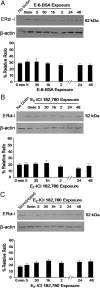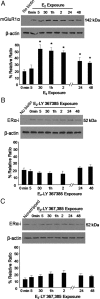Estradiol-induced estrogen receptor-alpha trafficking
- PMID: 19955385
- PMCID: PMC2836237
- DOI: 10.1523/JNEUROSCI.2107-09.2009
Estradiol-induced estrogen receptor-alpha trafficking
Abstract
Estradiol has rapid actions in the CNS that are mediated by membrane estrogen receptors (ERs) and activate cell signaling pathways through interaction with metabotropic glutamate receptors (mGluRs). Membrane-initiated estradiol signaling increases the free cytoplasmic calcium concentration ([Ca(2+)](i)) that stimulates the synthesis of neuroprogesterone in astrocytes. We used surface biotinylation to demonstrate that ERalpha has an extracellular portion. In addition to the full-length ERalpha [apparent molecular weight (MW), 66 kDa], surface biotinylation labeled an ERalpha-immunoreactive protein (MW, approximately 52 kDa) identified by both COOH- and NH(2)-directed antibodies. Estradiol treatment regulated membrane levels of both proteins in parallel: within 5 min, estradiol significantly increased membrane levels of the 66 and 52 kDa ERalpha. Internalization, a measure of membrane receptor activation, was also increased by estradiol with a similar time course. Continuous treatment with estradiol for 24-48 h reduced ERalpha levels, suggesting receptor downregulation. Estradiol also increased mGluR1a trafficking and internalization, consistent with the proposed ERalpha-mGluR1a interaction. Blocking ER with ICI 182,780 or mGluR1a with LY 367385 prevented ERalpha trafficking to and from the membrane. Estradiol-induced [Ca(2+)](i) flux was also significantly increased at the time of peak ERalpha activation/internalization. These results demonstrate that ERalpha is present in the membrane and has an extracellular portion. Furthermore, membrane levels and internalization of ERalpha are regulated by estradiol and mGluR1a ligands. The pattern of trafficking into and out of the membrane suggests that the changing concentration of estradiol during the estrous cycle regulates ERalpha to augment and then terminate membrane-initiated signaling.
Figures





Similar articles
-
Estradiol rapidly regulates membrane estrogen receptor alpha levels in hypothalamic neurons.J Neurosci. 2010 Sep 22;30(38):12589-96. doi: 10.1523/JNEUROSCI.1038-10.2010. J Neurosci. 2010. PMID: 20861365 Free PMC article.
-
Membrane estrogen receptor-alpha interactions with metabotropic glutamate receptor 1a modulate female sexual receptivity in rats.J Neurosci. 2007 Aug 29;27(35):9294-300. doi: 10.1523/JNEUROSCI.0592-07.2007. J Neurosci. 2007. PMID: 17728443 Free PMC article.
-
Membrane estrogen receptor-alpha interacts with metabotropic glutamate receptor type 1a to mobilize intracellular calcium in hypothalamic astrocytes.Endocrinology. 2009 Mar;150(3):1369-76. doi: 10.1210/en.2008-0994. Epub 2008 Oct 23. Endocrinology. 2009. PMID: 18948402 Free PMC article.
-
Physiology of membrane oestrogen receptor signalling in reproduction.J Neuroendocrinol. 2009 Mar;21(4):249-56. doi: 10.1111/j.1365-2826.2009.01833.x. J Neuroendocrinol. 2009. PMID: 19207814 Free PMC article. Review.
-
Membrane-initiated estradiol actions mediate structural plasticity and reproduction.Front Neuroendocrinol. 2012 Oct;33(4):331-41. doi: 10.1016/j.yfrne.2012.07.003. Epub 2012 Jul 22. Front Neuroendocrinol. 2012. PMID: 22828999 Free PMC article. Review.
Cited by
-
A selective membrane estrogen receptor agonist maintains autonomic functions in hypoestrogenic states.Brain Res. 2013 Jun 13;1514:75-82. doi: 10.1016/j.brainres.2013.03.020. Epub 2013 Mar 25. Brain Res. 2013. PMID: 23535448 Free PMC article. Review.
-
The Neurosteroid Progesterone Underlies Estrogen Positive Feedback of the LH Surge.Front Endocrinol (Lausanne). 2011 Dec 2;2:90. doi: 10.3389/fendo.2011.00090. eCollection 2011. Front Endocrinol (Lausanne). 2011. PMID: 22654832 Free PMC article.
-
Fluorescently-Labeled Estradiol Internalization and Membrane Trafficking in Live N-38 Neuronal Cells Visualized with Total Internal Reflection Fluorescence Microscopy.J Steroids Horm Sci. 2013 Apr 20;Suppl 12:10.4172/2157-7536.S12-002. doi: 10.4172/2157-7536.S12-002. J Steroids Horm Sci. 2013. PMID: 24353903 Free PMC article.
-
Membrane estradiol signaling in the brain.Front Neuroendocrinol. 2009 Aug;30(3):315-27. doi: 10.1016/j.yfrne.2009.04.011. Epub 2009 May 4. Front Neuroendocrinol. 2009. PMID: 19416735 Free PMC article. Review.
-
Sex differences in central endozepine expression and regulation of appetite.Physiol Behav. 2025 Oct 1;299:115003. doi: 10.1016/j.physbeh.2025.115003. Epub 2025 Jun 17. Physiol Behav. 2025. PMID: 40553808
References
-
- Azcoitia I, Sierra A, Garcia-Segura LM. Localization of estrogen receptor beta-immunoreactivity in astrocytes of the adult rat brain. Glia. 1999;26:260–267. - PubMed
-
- Beyer C, Pawlak J, Karolczak M. Membrane receptors for oestrogen in the brain. J Neurochem. 2003;87:545–550. - PubMed
-
- Bollig A, Miksicek RJ. An estrogen receptor-alpha splicing variant mediates both positive and negative effects on gene transcription. Mol Endocrinol. 2000;14:634–649. - PubMed
Publication types
MeSH terms
Substances
Grants and funding
LinkOut - more resources
Full Text Sources
Miscellaneous
